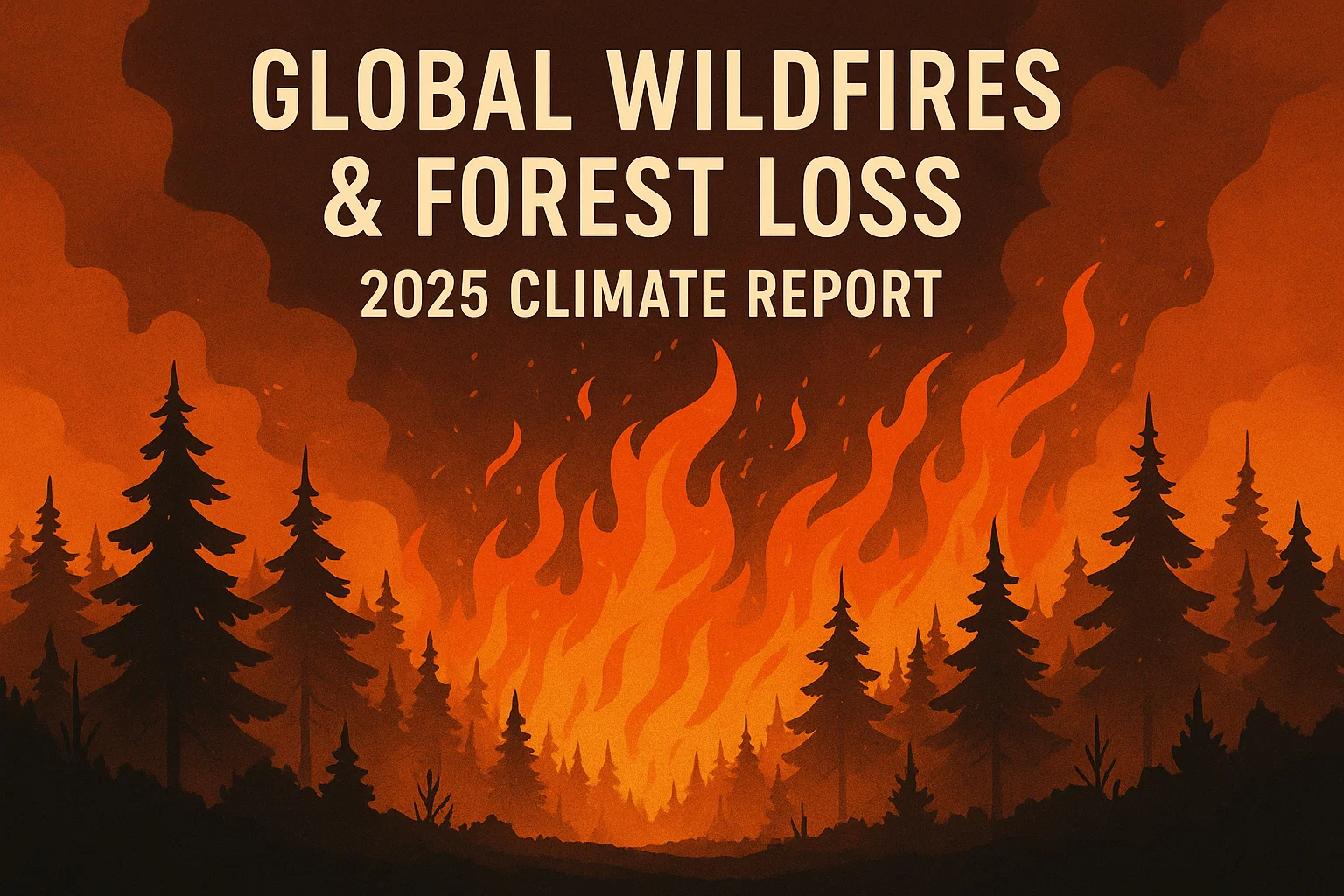Global Wildfires & Forest Loss – 2025 Climate Report
Explore the 2025 State of the Climate Report on global wildfires and forest loss. Learn about causes, impacts, and the urgent climate implications behind record-breaking tree cover loss.
2025 State of the Climate Report:
The 2025 State of the Climate Report: A Planet on the Brink (October 30, 2025) has revealed alarming data — global tree cover loss reached nearly 30 million hectares (Mha) in 2024, marking the second-highest on record. Fire-related destruction surged 370% compared to 2023, signaling a severe escalation in climate-driven forest degradation and uncontrolled wildfires across continents.
What are Wildfires?
Wildfires, also known as forest fires or bushfires, are uncontrolled fires that spread rapidly through vegetation such as forests, grasslands, or shrublands. They can originate naturally — from lightning or spontaneous combustion — or through human-induced causes such as agricultural burning, discarded cigarettes, or deforestation. The “fire triangle” concept explains wildfire behaviour as a function of heat, oxygen, and fuel (dry vegetation). When all three components coexist under conducive conditions like drought and high winds, ignition can escalate into catastrophic fires.
Major Causes of Wildfires:
-
Climate Change:
Rising global temperatures, prolonged heatwaves, and severe droughts — particularly during El Niño years — have dramatically increased wildfire frequency and intensity. These climatic shifts dry out vegetation, turning vast forested regions into tinderboxes. -
Human Activities:
Agricultural burning, deforestation, land clearing, and accidental ignition from power lines or machinery remain primary triggers. Human negligence accounts for nearly 85% of wildfire outbreaks globally, according to the report. -
Natural Factors:
Natural igniters like lightning strikes, volcanic eruptions, and spontaneous combustion of organic material contribute to wildfire initiation, especially in tropical and boreal ecosystems. -
Land Use Change:
The fragmentation of forests and the expansion of agriculture or urban areas expose new ignition fronts, making previously resilient ecosystems vulnerable to fires.

Impacts of Wildfires:
Environmental Impacts:
-
CO₂ Emissions: In 2024, tropical forest fires emitted around 3.1 gigatonnes of CO₂ equivalent (CO₂e) — approximately 8% of total global greenhouse gas emissions, worsening the global warming trajectory.
-
Deforestation & Biodiversity Loss: Over 3.2 million hectares of tropical primary forests were lost in 2024, leading to the extinction risk of numerous species. Global wildlife populations have declined 73% in the last 50 years, largely due to habitat loss and climate stress.
-
Climate Feedback Loop: Wildfires act as both a cause and consequence of global warming. They release greenhouse gases that increase temperatures, which in turn create conditions conducive to more fires — forming a dangerous feedback cycle.
-
Soil & Water Impact: Fires strip the soil of nutrients, increase erosion, and alter hydrological cycles, contributing to desertification and loss of water retention capacity.
-
Oceanic Impact: Fire-related soot and aerosols travel across oceans, settling on coral reefs and marine ecosystems, impairing photosynthesis and oceanic biodiversity.
Health and Social Impacts:
-
Public Health Crises: Wildfire smoke contains fine particulate matter (PM2.5) that penetrates deep into the lungs, triggering respiratory and cardiovascular diseases. Prolonged exposure increases asthma, bronchitis, and even cancer risks.
-
Displacement & Livelihood Loss: Indigenous and forest-dependent communities are disproportionately affected, losing homes, ancestral lands, and income sources.
-
Economic Damages: In 2025 alone, California wildfires caused estimated damages of $250 billion, disrupting infrastructure and energy networks.
Ecological & Long-Term Risks:
-
Amazon at Risk: Scientists warn that nearly 47% of the Amazon rainforest could undergo irreversible ecosystem transitions by 2050, turning into savannah-like landscapes.
-
Global Ecosystem Imbalance: Coral reefs, wetlands, and mangroves are under increasing stress from the cascading effects of fires, pollution, and rising sea temperatures — collectively accelerating the climate crisis.
Conclusion:
The surge in global wildfires and forest loss highlights an urgent need for global climate resilience, reforestation, and stronger environmental governance. Nations must prioritize wildfire early warning systems, enforce sustainable land-use policies, and fulfill commitments under the Paris Agreement to limit global warming. Without immediate action, the growing wildfire crisis could push the planet beyond ecological tipping points — making “A Planet on the Brink” not just a report title, but a stark global reality.
Subscribe to our Youtube Channel for more Valuable Content – TheStudyias
Download the App to Subscribe to our Courses – Thestudyias
The Source’s Authority and Ownership of the Article is Claimed By THE STUDY IAS BY MANIKANT SINGH





